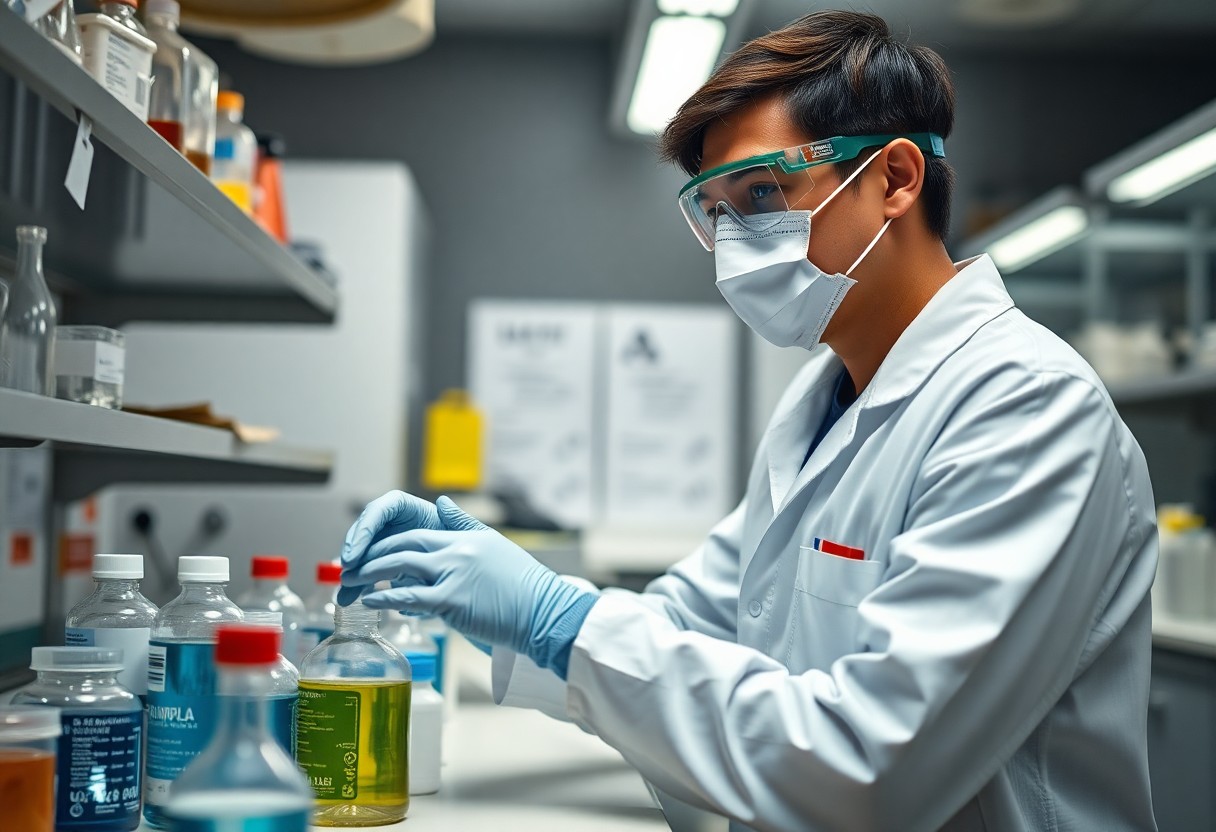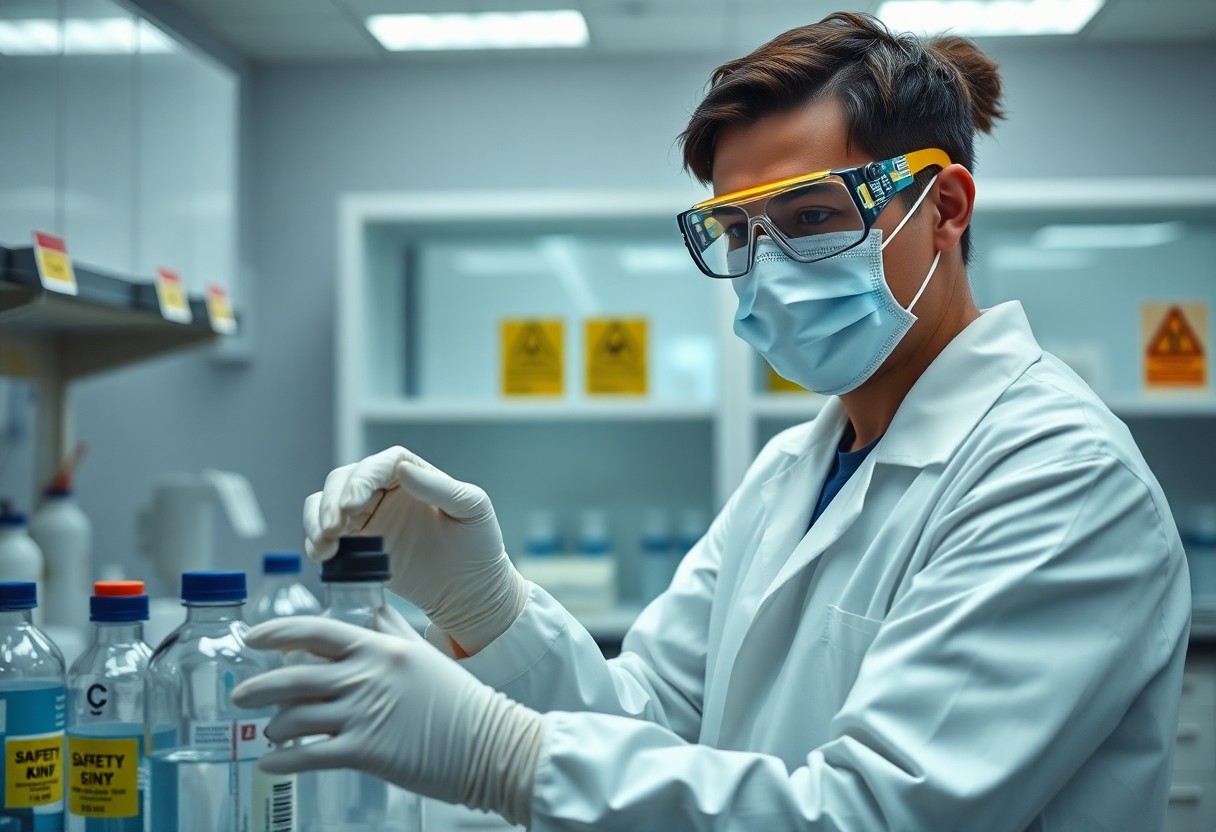Understanding the Risks: The Dangers of Chemical Exposure
The health risks associated with chemical exposure vary significantly, depending on the type of chemical and level of exposure. You might be surprised to learn that exposure to certain chemicals can lead to acute effects, including symptoms like headaches, respiratory distress, or skin irritation, often seen with solvents and cleaning agents. Chronic exposure to hazardous substances creates long-term risks, such as cancer or reproductive health issues. For example, consistent contact with certain pesticides has been linked to various serious health conditions. Always treat chemicals as potential threats to your health by being aware of their properties and associated dangers.
Key Takeaways:
- Always read and understand the Safety Data Sheet (SDS) for each chemical to ensure proper handling and awareness of hazards.
- Use personal protective equipment (PPE) such as gloves, goggles, and lab coats to minimize exposure and enhance safety.
- Follow proper storage and disposal guidelines for chemicals to prevent accidents and ensure compliance with regulations.

Essential Protective Measures: Personal Safety Gear You Can’t Ignore
Handling chemicals requires you to prioritize your personal safety by utilizing the appropriate Personal Protective Equipment (PPE). From gloves and goggles to respiratory masks, the right safety gear acts as your first line of defense against hazardous exposure. Neglecting to wear the correct PPE could lead to serious health risks, including respiratory issues, skin absorption, and eye injuries, so choose your gear wisely based on the chemicals you’re working with and the potential risks involved.
Selecting the Right PPE
Choosing the appropriate PPE starts by assessing the specific chemicals you’ll be working with. For instance, nitrile gloves are better suited for solvents, while latex may suffice for less hazardous substances. Protective eyewear should have anti-fog capabilities when working in humid environments. Conduct a thorough risk assessment to determine whether you need a full-face respirator or simply a disposable mask to ensure maximum safety.
Best Practices for Usage and Maintenance
Proper usage and maintenance of PPE extend its lifespan and enhance safety. Always inspect gear for any signs of damage before use; if gloves have holes or goggles are cracked, replace them immediately. Cleaning must be conducted according to manufacturer guidelines, especially for reusable items. Store your PPE in a designated, clean area away from direct sunlight or temperature extremes to preserve its integrity.
Establishing a routine for PPE care is vital for ensuring your safety. This includes regular cleaning and checking for wear and tear, ideally after each use. For items like respirators, replace filters according to your workflow and exposure levels. Wearing PPE correctly also matters—secure your goggles to prevent any slip, and ensure gloves cover the wrists adequately. This attention to detail not only protects you but also reinforces a culture of safety within the workplace.
Safe Handling Protocols: Mastering Chemical Interaction
Implementing effective safety protocols is key to mitigating risks when working with chemicals. First, familiarize yourself with material safety data sheets (MSDS) for each substance, which outline hazards and safe usage guidelines. Developing a systematic approach to mixing or utilizing chemicals can substantially minimize dangerous reactions. Always wear appropriate personal protective equipment (PPE) and keep emergency supplies within easy reach. Training and regular safety drills can also enhance preparedness, ensuring that you are ready to react swiftly and safely should an incident occur.
Proper Storage Techniques
Properly storing chemicals maintains their efficacy and safety, reducing the chance of accidents. Utilize labeled containers that comply with safety standards, and store incompatible substances separately to prevent hazardous reactions. Maintain a clean, organized storage area, ensuring that shelving is sturdy and items are securely placed. Temperature control should also be considered, keeping chemicals in cool, dry places away from direct sunlight or heat sources.
Transportation Safety Guidelines
Adhering to transportation safety guidelines significantly lowers the risk of spills and exposure while moving chemicals. Always utilize secondary containment, such as spill trays or leak-proof carriers, to prevent any potential leaks. Ensure that containers are securely closed and labeled clearly with contents and hazard warnings. During transport, prioritize a stable, upright position and minimize vibrations, which can lead to accidents. When moving larger quantities, consider using specialized vehicles equipped for carrying hazardous materials.
Transporting chemicals requires diligence and adherence to regulations. Depending on the quantity and type of chemicals, you may need to follow specific routes or utilize vehicles that meet safety standards. Be aware of local laws regarding hazardous materials transportation, and prepare for potential emergencies by having spill response kits and trained personnel available during transit. This holistic approach ensures that no matter where you’re headed with your materials, safety remains the top priority.
Emergency Readiness: Responding to Chemical Incidents
Preparedness for chemical incidents is non-negotiable in any workplace handling hazardous materials. Establishing a clear response strategy ensures you’re equipped to manage emergencies effectively, minimizing potential harm to you and your colleagues. Regular drills and training sessions keep everyone up to date on procedures, enabling swift and safe responses to spills, leaks, or exposure scenarios. Maintaining an accessible supply of emergency equipment, like spill kits and first aid supplies, is also vital to a solid emergency plan.
Developing an Effective Spill Response Plan
An effective spill response plan identifies potential hazards specific to your work environment and outlines the step-by-step actions you need to take in the event of a spill. Key elements include designated cleanup crews, proper containment methods, communication procedures, and necessary personal protective equipment (PPE). Incorporating clear guidelines for reporting incidents and documenting spills further enhances your plan’s reliability, ensuring a systematic approach to any unforeseen events.
First-Aid Measures for Chemical Burns and Inhalation
In cases of chemical burns and inhalation, immediate and appropriate first-aid measures can significantly reduce long-term injuries. For skin contact, quickly flush the area with copious amounts of water for at least 15 minutes, and remove any contaminated clothing. In case of inhalation, moving the individual to fresh air without delay is vital to minimize respiratory damage. Always seek professional medical assistance to ensure the affected person receives appropriate treatment.
For chemical burns, cooling the burn with water helps to stop the burning process and alleviates pain. It’s important not to apply ointments or creams before professional medical evaluation, as they can complicate the injury. In the case of inhalation, reassuring the individual and ensuring they are calm aids recovery. If symptoms escalate, such as difficulty breathing or persistent coughing, emergency medical services should be contacted immediately. Knowledge of specific chemical properties aids in providing accurate information to first responders, ultimately enhancing the affected individual’s treatment.
Creating a Safety Culture: Engaging Your Team in Chemical Safety
A strong safety culture is fostered through active engagement and communication among team members. By involving everyone in decisions about chemical safety, you create a sense of ownership and accountability. Encourage your colleagues to speak up about safety concerns, share experiences, and contribute ideas for improvement, which reinforces the importance of safety in the workplace. A culture that prioritizes safety leads to more vigilant practices and ultimately, better protection against chemical hazards.
Training Programs and Resources
Implementing comprehensive training programs equips your team with the necessary knowledge to handle chemicals safely. These programs should cover proper handling techniques, emergency procedures, and the use of personal protective equipment (PPE). Utilize a variety of resources, including online courses, workshops, and hands-on training sessions, to ensure that all employees can access valuable information tailored to their specific roles.
Building Awareness and Accountability
Awareness is the foundation of a proactive safety culture. Regular safety meetings and updates keep chemical safety at the forefront of your team’s mind. You can encourage accountability by establishing clear roles and responsibilities related to chemical safety, alongside easy-to-understand protocols. For instance, assigning specific safety monitors or “safety champions” within teams can promote vigilance and motivate others to adhere to safety standards.
Building awareness and accountability also involves regularly reinforcing the importance of safety practices through visual reminders, such as signage and infographics around the workplace. You could provide resources like checklists for safe chemical handling or incident reporting frameworks. Implementing a system for recognizing safe behaviors can further motivate individuals and teams to prioritize chemical safety. For instance, spotlighting a “Safety Star” of the month encourages engagement and fosters a positive safety culture where all employees feel responsible for one another’s well-being.
To wrap up
As a reminder, when working with chemicals, you must handle them with care to ensure your safety and the safety of those around you. Always use appropriate personal protective equipment, follow safety guidelines, and properly store chemicals to prevent accidents and mishandling. Being aware of the risks associated with the substances you work with will empower you to take the necessary precautions and maintain a safe working environment. Your diligence in these matters is vital for effective chemical management.
Q: What basic safety measures should be taken when working with chemicals?
A: When working with chemicals, it is crucial to wear appropriate personal protective equipment (PPE) such as gloves, goggles, and lab coats to prevent skin and eye irritation. Additionally, ensure that you work in a well-ventilated area and utilize fume hoods when necessary. Familiarize yourself with the Material Safety Data Sheets (MSDS) for all chemicals being used, which provide important information about handling, storage, and emergency procedures. Always label containers clearly and keep incompatible substances separated to reduce risks.
Q: How should chemicals be stored safely in the workplace?
A: Chemicals should be stored according to their compatibility and hazard classifications to prevent reactions. Use proper storage cabinets for flammable, corrosive, or reactive substances. Ensure containers are tightly sealed to minimize the risk of spills or vapors escaping. Maintain a clean and organized storage area, free from clutter, and conduct regular inspections to check for leaks or deterioration of containers. It’s also important to ensure that the storage area is clearly labeled and access is restricted to trained personnel only.
Q: What steps should be taken in case of a chemical spill or exposure?
A: In the event of a chemical spill, the first step is to evacuate the area and ensure that affected personnel are moved to a safe location. Assess the situation and determine if containment can be achieved safely. Always have spill kits available, equipped with absorbents and protective gear. Notify the appropriate personnel or emergency services if the spill is significant or poses a risk to health. For exposure, rinse the affected area with plenty of water and seek medical assistance immediately if necessary. Document the incident and review safety protocols to prevent future occurrences.
